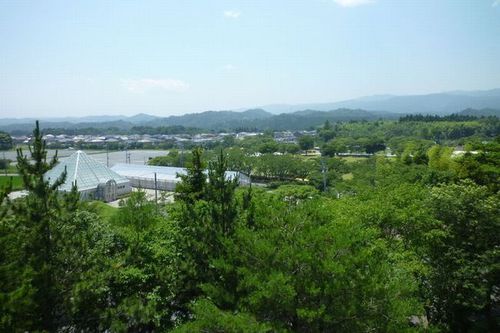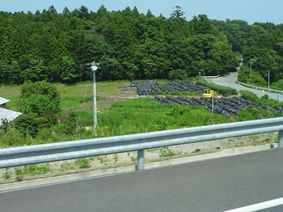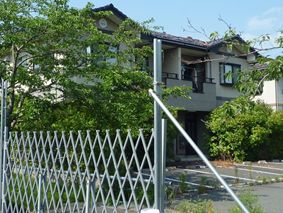September 11, 2015
Hirono Wai-Wai Project to Accelerate Recovery of Disaster-Stricken Areas
Keywords: Disaster Reconstruction Newsletter
JFS Newsletter No.156 (August 2015)
The Fukushima Daiichi Nuclear Power Station, which suffered an accident following the Great East Japan Earthquake in March 2011, lies between Okuma and Futaba Towns in Futaba District, Fukushima Prefecture. Futaba District consists of six towns, Hirono, Naraha, Tomioka, Okuma, Futaba and Namie, and two villages, Kawauchi and Katsurao. All are located within a 30-kilometer radius of the nuclear plant.
In this newsletter, we introduce the kick-off event of the "Hirono Wai-Wai Project to Call for Spring in Futaba's Eight Towns and Villages," which was selected as the New Tohoku Model Pilot Project in FY2015. We also look at the current conditions in the disaster-stricken areas and efforts toward their reconstruction.
The Tohoku Region, which was heavily impacted by the 2011 earthquake, had already been experiencing a number of social problems, including depopulation, rising average age of citizens and hollowing out of industry, even before the earthquake. Using reconstruction of the disaster-stricken areas as an opportunity, the Reconstruction Agency of Japan has been working to overcome these problems and create a "New Tohoku" to serve as a model for other regions in Japan and the world. The New Tohoku Model Pilot Project mentioned above is one of the agency's initiatives.
This project is expected to help various stakeholders develop their own initiatives actively, leading to Tohoku's sustained vitalization. It aims to select and nurture pioneering initiatives from a wide variety of players, including companies, universities and non-profit organizations (NPOs), and expand these initiatives in the affected areas.
An exchange event called the "8th Kurumaza (meaning 'sit in a circle') in Hirono Town" was held on July 10 and 11, 2015. The Yui-Yui Project, launched by JKSK Empowering Women Empowering Society (a certified non-profit organization), has been holding this event regularly since July 2011 to support victims of the 2011 earthquake. It provides a platform for exchanging of views between female leaders continuing active efforts for the future of areas undergoing reconstruction and female experts in the Greater Tokyo Area aspiring to support reconstruction. Together, they hold discussions and consider launching specific actions.
At the latest kurumaza, local citizens and visitors from the Tokyo area toured the local resources in the town. Then they conducted a workshop to exchange ideas on how to use these resources to help make the town more attractive.
The Hirono Wai-Wai Project aims to create sources of "liveliness and livelihood (jobs)" in Hirono by connecting new local initiatives with each other. Such initiatives include renovating the Futatsunuma multi-purpose park, developing a disaster-prevention green space, reopening the mandarin orchard, and cultivating olives and organic cotton. In cooperation with Iwaki, Fukushima Prefecture; Tokyo area groups; and the Tomioka Civil Engineering Office in Fukushima Prefecture, Hirono is playing a central role in promoting the return of local citizens and in rebuilding Naraha and Tomioka, to which citizens are expected to start returning home soon, in an effort to accelerate the reconstruction of the eight towns and villages of Futaba District.
The kurumaza event was kicked off with a program informing the 21 participants from the Tokyo area of the current situation in the affected areas. They visited Hirono and heard how reconstruction of the town was progressing.
Hirono is located within 20 to 30 kilometers of the Fukushima Daiichi Nuclear Power Station. On March 13, 2011, the mayor issued an evacuation directive targeting all residents. Although the directive was lifted on March 31, 2012, slightly more than 2,100 people, only about 40 percent of the residents, had resumed living there as of June 30, 2015. More than half of the residents continue to live away from the town.
More than three years have passed since the lifting of the evacuation directive. It is said that the immediate tasks for promoting the return of former residents to the town are building infrastructure and creating jobs. In order for disaster-affected residents to feel hopeful about the future and return to the town with assurance, not only do the immediate tasks need to be accomplished, but discussions must continue with the disaster-affected residents and plans must be revised flexibly in accordance with the situation. Such measures are indispensable and will require much time.
The Hirono town government released the Hirono Town Reconstruction Plan (second version) on March 31, 2014, covering the ten years from fiscal 2012 to 2021, revised from the original plan. It encompasses four basic town-building principles, i.e., building a town where anyone can live with peace of mind; a safe and secure town with a disaster-resistant urban foundation and heart-to-heart relationships as its basis; a vigorous town that creates new industries destined to play major global roles in the 21st century; and an active town that plays a role in reconstructing the Futaba region.
After hearing about the current situation of Hirono, participants visited disaster-stricken areas nearby.
The decision has been made to lift the evacuation directive on Naraha, north of Hirono (closer to the Fukushima Daiichi Nuclear Power Station), on September 5, 2015. The directive has been in force about four and half years. The first thing one sees upon entering Naraha is a large number of black bags in what resembles a weed-infested lot. In the black bags, called flexible containers, are soil and grass with radiological contaminants collected during decontamination work. What looks like an empty lot used to be a paddy field before the earthquake.
Tomioka, north of Naraha, has "areas in which residents are not permitted to live" and "areas where it is expected that residents will face difficulties in returning for a long time." Residents with houses in the former receive permission once a month to enter their houses, but those with houses in the latter are not allowed that and have thus been unable to service their own houses at all since the earthquake.
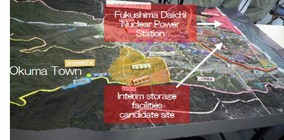 In Okuma, where the Fukushima Daiichi Nuclear Power Station is located, the majority of residential areas have been designated as "areas where it is expected that residents will face difficulties in returning for a long time." Furthermore, a site near the nuclear power station has been chosen for use as interim storage facilities, where soil and grass with radiological contaminants collected during decontamination work are stored and managed until their permanent disposal can be arranged.
In Okuma, where the Fukushima Daiichi Nuclear Power Station is located, the majority of residential areas have been designated as "areas where it is expected that residents will face difficulties in returning for a long time." Furthermore, a site near the nuclear power station has been chosen for use as interim storage facilities, where soil and grass with radiological contaminants collected during decontamination work are stored and managed until their permanent disposal can be arranged.
The national government has instituted a policy of lifting restrictions on living and access by the end of March 2017. There are many tasks to be solved, however, including rebuilding necessary infrastructure for the residents' return and addressing psychological barriers such anxiety over safety of living near interim storage facilities.
A program was prepared for the participants after their visit to the disaster-affected areas to teach them more about Hirono. After returning to the town, they listened to presentations on reconstruction and community building activities being carried out in and around the town. The participants stayed the night at local volunteers' houses, so in the evening, they engaged in long conversations, deepening their exchange.
During the morning session on the second day of the kurumaza, the participants visited an organic cotton field, the green area for disaster prevention, an olive plantation in the Futatsunuma multi-purpose park and other places, gaining deeper familiarity with the local resources as well as the actual sites where the Hirono Wai-Wai Project activities are to take place.
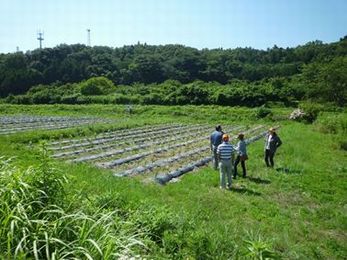
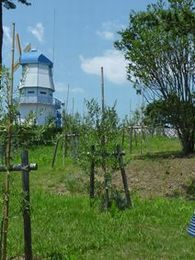
Left: Organic cotton field, Right: Olive plantation
In the afternoon, there was a workshop with about 50 members, including Hirono residents, implemented in the World Cafe style. The participants expressed their views on specific details of three activities, the Hirono Park Festival, Present Tree in Hirono and Women's Handiwork Creation, being held as part of the Hirono Wai-Wai Project.
The Hirono Park Festival is held periodically to restore a safe, fun environment to the community. To create a lively atmosphere, it includes events at the Futatsunuma multi-purpose park, which had been closed till May 2015 because of the 2011 earthquake.
The Present Tree in Hirono will make use of the green area for disaster prevention, which will be ready by March 2016, where individuals and companies from inside and outside the town will plant trees. The aim of this activity is to develop long-term relationships with people outside the town by involving them in tree planting and becoming foster parents of the trees.
Women's Handiwork Creation will direct the talents of women in the community toward creating and promoting a new Hirono brand by developing new products utilizing olives, mandarins, organic cotton cultivated with the help of volunteers from the Tokyo area, and other Hirono specialties.
The participants from both the local community and the Tokyo area brought various views and ideas to the workshop and held sustained, passionate discussions in a pleasant atmosphere. After the workshop, one local participant said, "Now I think I can do something," and another said "I want to create a cafe that will be like a salon where people can interact freely." These comments indicate positive attitudes toward implementation of actual projects.
Tokyo area participants commented, "Listening to the local people's true feelings helped me absorb their emotions in my heart before I shared my own views with them," and "This workshop provided me insight into the actual situation beyond what the news reports." These comments suggest that the sense of distance they had felt between themselves and Hirono had decreased.
As far as the actual situation in the disaster-affected areas goes, there are so many things a person can never know unless he or she actually goes to the areas and interacts with the local people. It would be unrealistic, however, for visiting individuals with no connection to the disaster-affected areas to try to ask local people to talk about their experiences.
The Hirono Wai-Wai Project initiatives are not exclusive to the locals, but accelerate reconstruction efforts by promoting exchange with people from outside. It is hoped that this project will serve as a good example for other disaster-affected areas, in which people who are not direct victims of the disaster can consider what happened and is happening in the disaster-affected areas as matters relevant to themselves. Then they can seek out what can be done within their own capacity and find actual opportunities to do what they can.
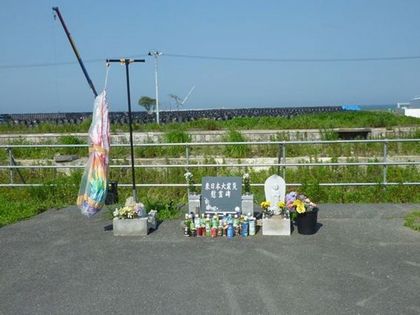
Written by Nobuhiro Tanabe
Related
"JFS Newsletter"
- 'Good Companies in Japan' (Article No.4): 'Eightfold Satisfaction' Management for Everyone's Happiness
- "Nai-Mono-Wa-Nai": Ama Town's Concept of Sufficiency and Message to the World
- 'Yumekaze' Wind Turbine Project Connects Metro Consumers and Regional Producers: Seikatsu Club Consumers' Co-operative
- Shaping Japan's Energy toward 2050 Participating in the Round Table for Studying Energy Situations
- 'Good Companies in Japan' (Article No.3): Seeking Ways to Develop Societal Contribution along with Core Businesses


